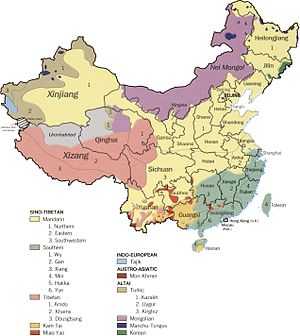Mongols in China
|
This map shows the Mongol autonomous subjects in the PRC | |
| Total population | |
|---|---|
| 5,981,840[1][2] Buryats · Southern Mongols · Oirats (2010) | |
| Regions with significant populations | |
| Inner Mongolia · Qinghai · Xinjiang | |
| Languages | |
| Mongolian · Oirat · Buryat | |
| Religion | |
| Mongolian shamanism · Tibetan Buddhism · Islam | |
| Related ethnic groups | |
| Mongols |

Mongols in China (Chinese: 蒙古族 Ménggǔzú) are citizens of the People's Republic of China who are ethnic Mongols. They form one of the 55 ethnic minorities officially recognized by the People's Republic of China. There are approximately 5.8 million people classified as ethnic Mongols living in China. Most of them live in Inner Mongolia, Northeast China, Xinjiang, etc. The Mongol population in China is over twice that of the sovereign state of Mongolia.
Regional distribution
The Mongols in China are divided between autonomous regions and provinces as follows:
- 68.72%: Inner Mongolia Autonomous Region
- 11.52%: Liaoning Province
- 2.96%: Jilin Province
- 2.92%: Hebei Province
- 2.58%: Xinjiang Uyghur Autonomous Region
- 2.43%: Heilongjiang Province
- 1.48%: Qinghai Province
- 1.41%: Henan Province
- 5.98%: Rest of mainland China
Besides the Inner Mongolia autonomous region, there are other Mongol autonomous administrative subdivisions in China.
On prefecture level:
- Haixi Mongol and Tibetan Autonomous Prefecture
- Bayingolin Mongol Autonomous Prefecture
- Bortala Mongol Autonomous Prefecture
On county level:
- Weichang Manchu and Mongol Autonomous County (Hebei)
- Harqin Left Mongol Autonomous County (Liaoning)
- Fuxin Mongol Autonomous County (Liaoning)
- Qian Gorlos Mongol Autonomous County (Jilin)
- Dorbod Mongol Autonomous County (Heilongjiang)
- Subei Mongol Autonomous County (Gansu)
- Henan Mongol Autonomous County (Qinghai)
- Hoboksar Mongol Autonomous County (Xinjiang)
Classification
China classifies diffent Mongolian groups like Buryats and Oirats into the same single category as Mongol along with Inner Mongols. A non-Mongolic ethnic group, the Tuvans are also classified as Mongols by China.[3] The official language used for all of these Mongols in China is a literary standard based on the Chahar dialect of Mongol.[4]
Related groups
Not all groups of people related to the medieval Mongols are officially classified as Mongols under the current system. Other official ethnic groups in China which speak Mongolic languages include:
- the Dongxiang of Gansu Province
- the Monguor of Qinghai and Gansu Provinces
- the Daur of Inner Mongolia
- the Bonan of Gansu Province
- some of the Yugurs of Gansu Province (other Yugurs speak a Turkic language)
Notable people
- Sengge Rinchen, Qing dynasty nobleman and general
- Ulanhu, politician, former Chairman of Inner Mongolia, former Vice President of the People's Republic
- Bayanqolu, Communist Party Secretary of Jilin province, former Party Secretary of Ningbo
- Uyunqimg, former Vice-Chair of the Standing Committee of the National People's Congress
- Fu Ying, Deputy Foreign Minister, former ambassador to the United Kingdom, Australia, and the Philippines
- Li Siguang, geologist, founder of China's geomechanics
- Yang Shixian, chemist, chancellor of Nankai University
- Siqingaowa, actress
- Mengke Bateer, CBA and NBA basketball player
- Bao Xishun, one of the tallest people in the world
- Tengger, a pop/rock musician
- Buren Bayaer, singer, composer and a disc jockey
- Uudam, child singer
- Zhang Xiaoping, boxer
- Sa Dingding, singer
- Chinggeltei (1924–2013), linguist, one of the world's few experts on the Khitan language
- Jalsan, linguist and Buddhist leader
- Batdorj-in Baasanjab, actor
- Xiao Qian academic
- Bai Xue lawyer and legal academic
- Bai Yansong, TV anchor
- Han Lei, pop singer
- Wang Lijun, disgraced police chief and political figure
See also
- Demographics of China
- Sichuan Mongols
- Upper Mongols
- Upper Mongolia
- Western Mongolia
- Yunnan Mongols
- Mongols in Taiwan
Gallery
-

Mongols
Further reading
- Human Rights in China: China, Minority Exclusion, Marginalization and Rising Tensions, London, Minority Rights Group International, 2007
References
- ↑ Түмэдхүү, ӨМӨЗО-НЫ ХҮН АМЫН ХУВИРАЛТЫН ЗУРГИЙГ ҮЗЭЭД (Southern) Mongolian Liberal Union Party (Mongolian): Millions of Han Chinese of Inner Mongolia Autonomous Region registered as "Mongol" and "Manchu" according to Chinese policy since the 1980s. There is no enough information about Chinese ethnic minorities due to the government policy.
- ↑ Өвөр Монголын хүн ам (Mongolian)
- ↑ Mongush, M. V. "Tuvans of Mongolia and China." International Journal of Central Asian Studies, 1 (1996), 225-243. Talat Tekin, ed. Seoul: Inst. of Asian Culture & Development.
- ↑ "Öbür mongγul ayalγu bol dumdadu ulus-un mongγul kelen-ü saγuri ayalγu bolqu büged dumdadu ulus-un mongγul kelen-ü barimǰiy-a abiy-a ni čaqar aman ayalγun-du saγurilaγsan bayidaγ." (Sečenbaγatur et al. 2005: 85).
- MONGUSH, M.V. (1996). "Tuvans of Mongolia and China". International Journal of Central Asian Studies 1: 225–243.
- (Mongolian) Sečenbaγatur, Qasgerel, Tuyaγ-a [Туяa], Bu. Jirannige, Wu Yingzhe, Činggeltei. 2005. Mongγul kelen-ü nutuγ-un ayalγun-u sinǰilel-ün uduridqal [A guide to the regional dialects of Mongolian]. Kökeqota: ÖMAKQ. ISBN 7-204-07621-4.
External links
- The Mongolian ethnic minority Chinese government information.
| ||||||||||||||||||||||||||||
| ||||||||||||||||||||
| |||||||||||||||||||||||||||||||||
| ||||||||||
